02 July 2014
Today did not go as planned.
I arose at 5:00, then coffee, cereal etc. Then web work.

Research materials for the Jane Addams Rail-trail write up.
I then got about the task of planning my hike for the day. It would be at Pinnacles State Park along the Mississippi River.
Once my maps were in order I collected my hiking gear prepared to head out. The sky had been crystal clear all morning but now there was total cloud cover and it looked pretty thick. Not the weather I had hoped for.
When I started up the van I noticed the "check tire" light was on. No big deal, I thought. But I always take a look. When I did I saw a completely flat front, drivers side tire. That was at about 10:00.
The van was parked on a slopping section of yard and the grass was wet and the ground was soft. So, I called AAA.
At about 11:40 a service truck showed up. I asked the driver to air up the tire to see what would happen. It was not good. The air immediately started to evacuate the puncture that was in the sidewall. That meant putting on the emergency spare and then getting the tire replaced.
Thankfully there was a WalMart near by. Imagine that! I got there about 12:45 and had both of the front tires replaced. The passenger side tire was due to be replaced in another 1000 miles or so and I thought it best to have two new drive tires on.
So, that was a nearly $300 expense I had not expected and it was nearly 2:00 by the time I got ready to leave Wally World.
Because most of the day was now eaten up and it was now on and off drizzle/downpour I decided on a closer destination: Apple River Canyon State Park.
Apple River Canyon State Park is in the hilly northwest corner of Illinois in Jo Daviess County near the Wisconsin border. Limestone bluffs, deep ravines, springs, streams and wildlife characterize this area. Once a part of a vast sea bottom that stretched from the Alleghenies to the Rockies, the scenic canyon area was formed by the action of the winding waters of the Apple River.
The park was established by the State of Illinois in 1932, and today consisting of 1.907 public owned acres. Several other sites within Jo Daviess County are managed as part of the Apple River Canyon State Park Complex: Thompson and Salem Units, Iris and Jack Witkowsky Wildlife Area, Tapley Woods Natural Area, Hanover Bluff Natural Area, Hanover Bluff Nature Preserve, Wards Grove Nature Preserve, McKeague Unit Nature Preserve, Rall Woods Natural Area, and Apple River Canyon - Winston Tunnel Unit.
Source: Illinois DNR
Click on the photos below for a larger image.

Apple River Canyon is primarily a picnicking, camping and fishing park. There are only a few miles of trails. I was on and off this loop trail before I knew what happened.

There were some interesting trees on the trail. Large Black walnuts, 3' DBH White Pines and this Juniper (?). The crown was so high I could not make it out but the bark seemed very familiar.

All of the limestone ledges were covered with Bulblet Bladder Fern (Cystopteris bulbifera) and a few plants of Canadian Yew (Taxus canadensis).
Both plants occur in my home state of West Virginia. The Bulblet Bladder Fern is what I would call "locally abundant". The Canadian Yew is rare. But I have seen it in WV.
Taxus canadensis (Canadian Yew) is a conifer native to central and eastern North America, thriving in swampy woods, ravines, riverbanks and on lake shores. Locally called simply "Yew", this species is also referred to as American Yew or Ground-hemlock.
Most of its range is well north of the Ohio River. It is, however, found as a rare ice age relict in some coves of the Appalachian Mountains. The southernmost colonies are known from Ashe and Watauga Counties in North Carolina.
It is usually a sprawling shrub, rarely exceeding 2.5 m tall. It sometimes forms strong upright central leaders, but these cannot be formed from spreading branches, only from the original leader of the seedling plant. The shrub has thin scaly brown bark. The leaves are lanceolate, flat, dark green, 1–2.5 cm long and 1.5 mm broad, arranged in two flat rows either side of the branch
.Source: WikiPedia
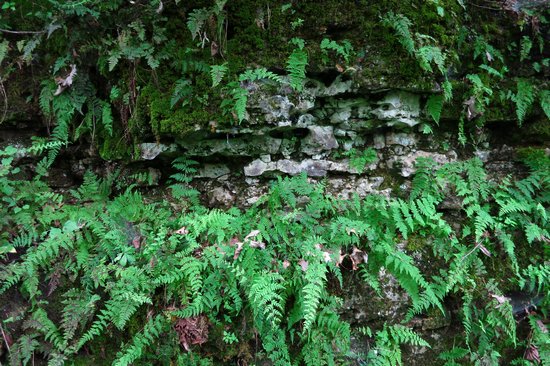
The limestone here seems to be in thin layers and rather loose in construction. I imagine it would crack and erode relatively easily. Good for limestone loving plants.

A look up the Apple River. The water was much clearer than any I had seen in the area. In the foreground you can see the flattened vegetation from the recent high waters.
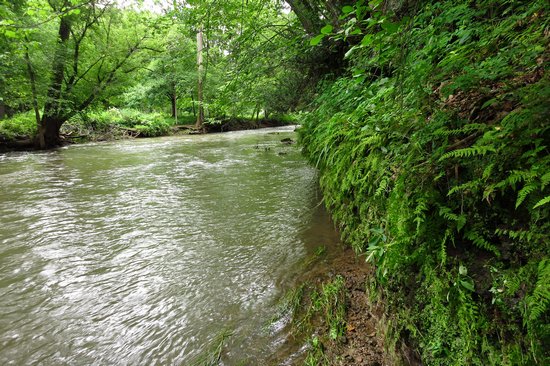
The ledges along the river were covered with more Bulblet Bladder Fern (Cystopteris bulbifera) and plants of Canadian Yew (Taxus canadensis).

I have seen lots of big Water Hemlock up this way. This lower section of stem which was exposed by the high water shows it's purplish base. Kinda purty!

When I finished up my hike I walked over to the bridge and was delighted to see this colony of Cliff Swallows.
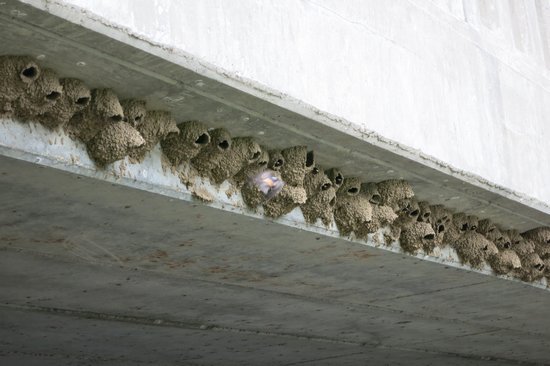
That blur in the middle is one of the swallows leaving it's jug like mud nest.

Click on the photo to see all the little heads peeking out.
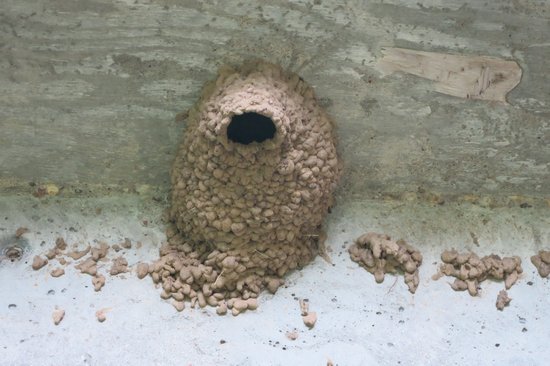
Amazing construction. I wonder how long it take to build one.
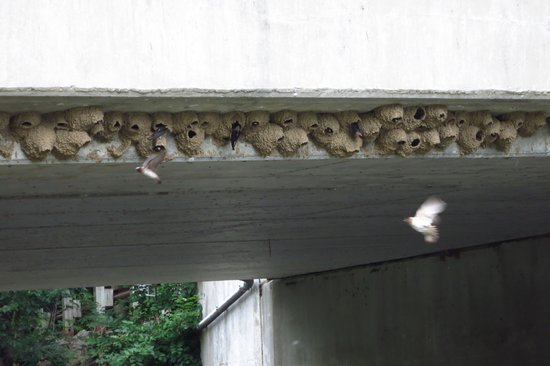
It was like Grand Central Station with all the birds flying in and out.
American cliff swallows breed in large colonies. They build conical mud nests and lay 3-6 eggs. The natural nest sites are on cliffs, preferably beneath overhangs, but as with the Eurasian house martin, man-made structures are now the principal locations for breeding. Female American cliff swallows are known to lay eggs in and move previously laid eggs into the nests of other birds within the colony.
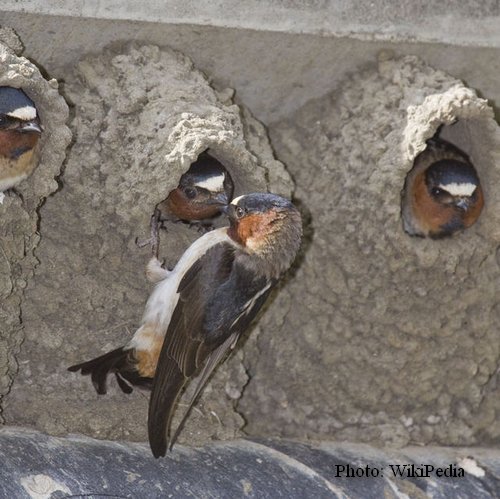
This species has always been plentiful in the west of North America, where there are many natural sites, but the abundance in the east has varied.
European settlement provided many new nest sites on buildings, but the population declined in the late nineteenth and early twentieth centuries as the supply of unpainted barns declined. There has been a subsequent revival as dams and bridges have provided suitable sites.
Source: WikiPedia

Here is one of the big Water Hemlock Cicuta maculata I mentioned earlier.
Cicuta, commonly known as water hemlock, is a small genus of four species of highly poisonous plants in the family Apiaceae. They are perennial herbaceous plants which grow up to 2.5 meters (8.2 ft) tall, having distinctive small green or white flowers arranged in an umbrella shape (umbel). Plants in this genus may also be referred to as cowbane or poison parsnip.
Water hemlock is considered one of North America's most toxic plants, being highly poisonous to humans. Three members of the genus contain a toxin named cicutoxin which causes central nervous system stimulatory effects including seizures following ingestion.
Source: WikiPedia
My 3 brothers and I had a close encounter of the deadly kind with a similar species back in January of 1969. Check out the write-up of the "Hemlock Incident".
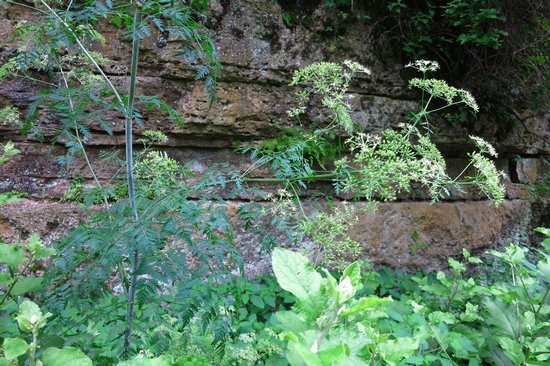
This is the species my brothers and I encountered - Poison Hemlock Conium maculatum.
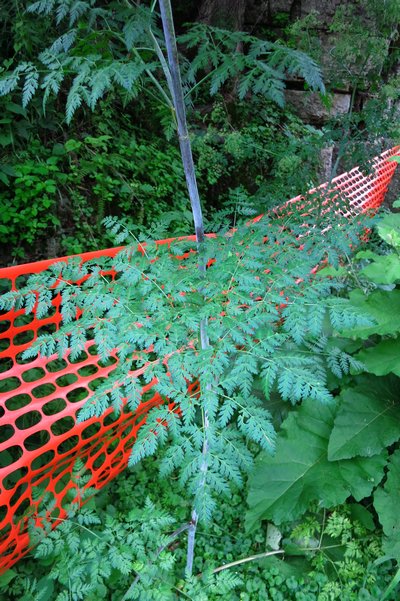
A plant one should be well acquainted with. But not just anyone would pull up the plant and start eating the tuber.
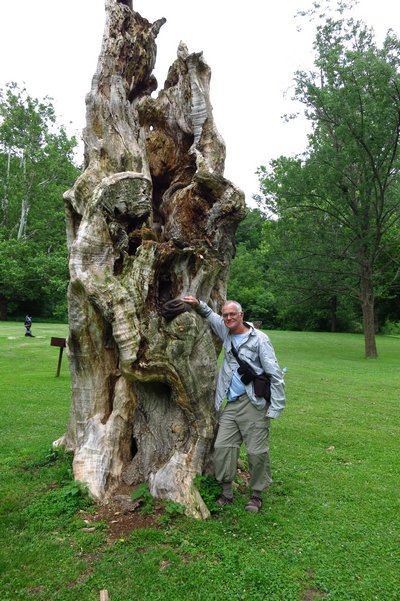
All that remains of a once giant Cottonwood tree (Populus deltoides).
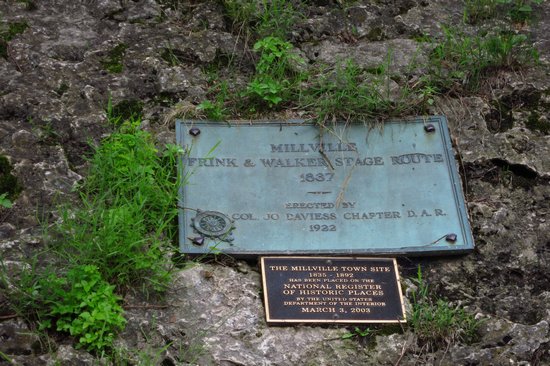
The plaque commemorates the Walker & Frink Stage Line which once went this way.
Although the first stagecoach ventured west out of Chicago to Fullersburg, 15 miles from Chicago, January 1, 1834, then the Indian boundary line, it was a man named Frink that set up the first successful stage line out of Chicago in 1836. His line was known as the Walker & Frink Stage Lines and their coaches started from a shanty-like building located in the heart of Chicago at the corner of Lake and Clark Streets. He fought all lines in true Chicago style, eventually emerging in complete control of the stages in and out of Chicago by 1860, covering a radius of 1,000 miles.
Source: saltcreekgreenwayassociation.org
And so ends my visit to Apple River Canyon State Park.
'Till next time...